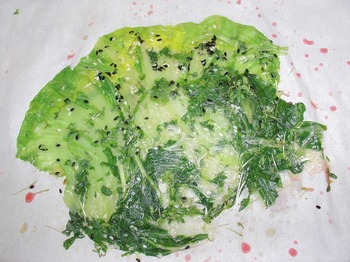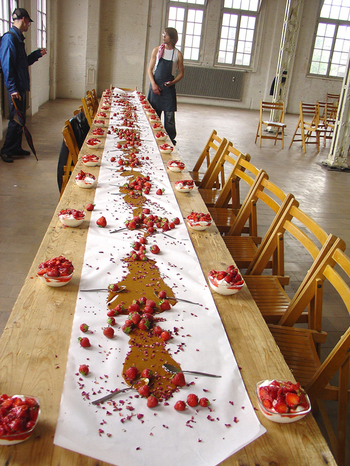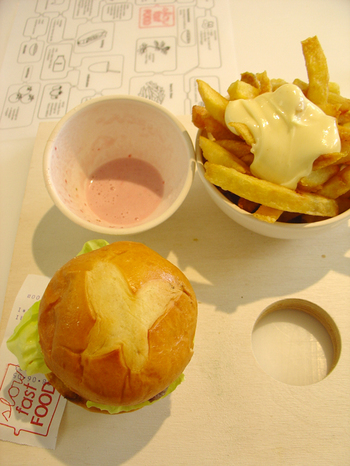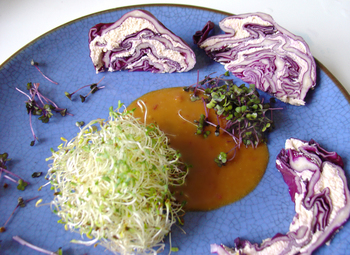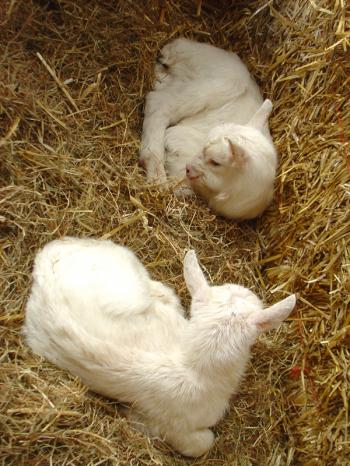Cinnamon & cardamom meringues
kosher for Pesach
April 22, 2008
I heart pareve desserts.
One of this year’s Pesach innovations was a sephardic-style seder dinner which more or less cancelled out last year’s innovation, the Pesach Ultra-lite. Whatevs, now that we’ve made these recipes our own, we can teach ourselves to make light of them. It’s about liberation.
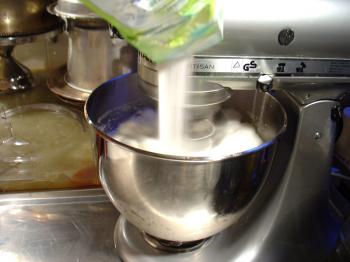
Links to standard meringue recipes below.
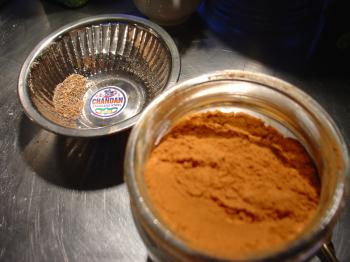
To our meringue mixture Marlein and I added a goodly amount of freshly ground cardamom and even more cinnamon. Heady and aromatic, you could probably burn the meringues as incense. Let’s check.
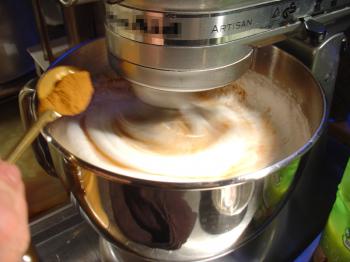
Whippity dippity do! Once out of the oven, the meringues were as spicy as peppermints.
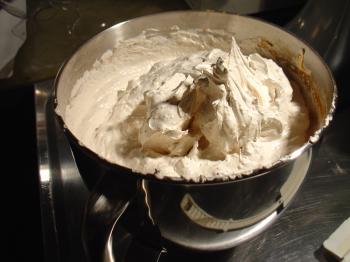
When you can hold the upturned bowl above your head without losing the meringue, it’s beaten stiffly enough. Don’t torture yourself, employ a machine for this heavy work.
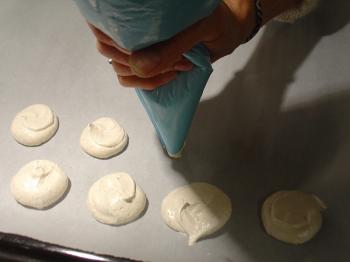
We used pastry bags to form the meringues into dots, hearts and doodley towers before popping them into the oven to dessicate.
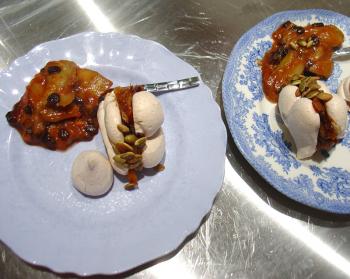
At the seder we served the meringues with our own variation on an Egyptian Haroset, and a molten spoonful of rhubarb fried with cinnamon and currants to give our sweet teeth a break.
- Debra and Marlein’s Sephardi-stylee haroset
- 1 part soft black dates, pitted (not joking about the ’soft’)
- 1 part figs, sliced thinly
- 1 part dried apricots, sliced thinly
- 1 part golden raisins
- lemon juice to taste
- orange zest to taste
- orange flower water to taste
- ground cinnamon, a goodly amount!
In a large bowl, mash the dates until you have a somewhat homogenous mixture. Stir in the figs, apricots and raisins. You can use a mixer with a dough hook if you think your arm will get tired. Alternately, you can cut through and fold the mixture with a plastic dough scraper.
Add the other ingredients to taste. Don’t be shy with the lemon juice. It will open up the other flavours. Marlein and I have been really into cinnamon lately, and we love the way that if you use a lot, it will give the food a fuller texture. Cinnamon is considered to have medicinal qualities which are beyond the scope of this blog. Suffice it to say that men should enjoy copious amounts of freshly ground cinnamon and Mum’s the word.
Meringue recipes and Jewy links:
-
A good, standard meringue recipe.
Note: to make meringues, all utensils must be completely grease-free. The egg-whites must contain no trace of yolk. You will also need to experiment with your own oven, until you can get it low enough. Your kitchen must be dry - don’t make soup and meringues at the same time.
A good instructional video of how to make meringues.
Similarities
-
Blood and swine are prohibited in kashrut and dhabiĥa halal.
Many animals permitted in kashrut are also dhabiĥa halal, such as bovines.
Kashrut and dhabiĥa halal guidelines both generally forbid the consumption of amphibian animals such as frogs. [According to kashrut, almost all insects are not kosher. The few kosher insects are specific types of locusts and grasshoppers which are seldom eaten today. It is also a consensus among Muslim scholars that most insects are forbidden except for locusts.
Kashrut states that kosher aquatic animals must have scales and fins. The most prevalent consensus among Muslim scholars is that in order to be dhabiĥa halal, the fish must have scales (nothing is said about fins). However, according to Jewish oral law all fish that have scales have fins, thus making all fish with scales kosher and thus the law being essentially the same dhabiĥa halal.
Differences
- For a substance to be dhabiĥa halal, it must not contain alcohol of any kind. The strictness of this with regard to the presence of extremely small quantities of alcohol in cooked foods depends largely on individual commitment and interpretation. Except for grape wine and grape juice (which must be manufactured under Jewish supervision), Kashrut allows any sort of alcohol, as long as it has no non-kosher ingredients (including any unsupervised grape extracts).
The list of animals forbidden by kashrut is more restrictive, as kashrut requires that, to be kosher, mammals must chew cud as well as have cloven hooves. Dhabiĥa halal requires that an animal have cloven hooves as well. Thus, various animals such as the camel are permissible as per dhabiĥa halal, but not according to kashrut.
Unless prepared according to a special process, the hindquarters of cows, sheep, goats, and other ruminants are not generally considered kosher. Dhabiĥa halal contains no such restriction regarding the hindquarters.
Kashrut prohibits shellfish such as lobster, shrimp, clams, and oysters, while there is debate among Muslim scholars regarding the status of shellfish; however, most Muslims consider all seafood halal and do eat shellfish.
debra at 14:52 | Comments (0) | post to del.icio.us
One little kid
Chad Gadya
April 19, 2008
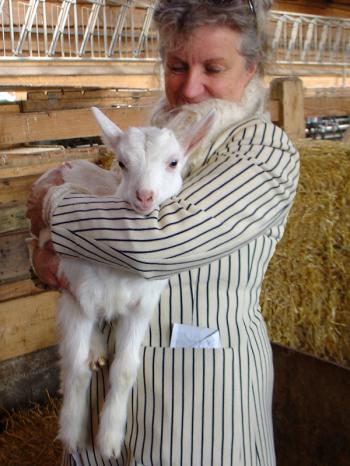
Happy Pesach! Are you 6 kilos?
Although we had sworn to recreate Pesach Ultra-Lite, Superior Powers and my own stubborn determination to not sit on the floor like my ancestors in the desert, dictated that we drop everything and become a trans-regional trucking company. We had a truck all right, but also an unfathomable lack of skill at both navigation and map reading. After completing the main job, we found ourselves very far away from home indeed and then suddenly, as if in a dream, we ended up at a goat farm.
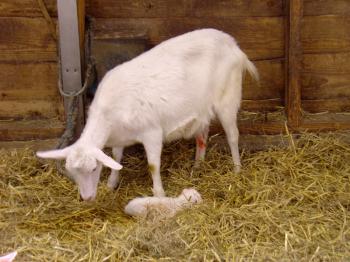
Newborn baby bokje, not enough meat on its bones, even according to Mama
Some weeks before, I had ordered a 6 kilo Pesach kid, so at the goat farm we went around picking up all the kids trying to find out what 6 kilos worth of goat felt like. Gawd knows this is how rumours get started. The exercise was both grim and funny, and then grim again.
In the nanny goat part of the barn, 2 kids had just been born, one was dead on arrival and the other was a very, very, tiny buck, a bit too tiny. The mama goat wasn’t entirely sure whether she should nurture the skinny bokje or step on its head. As the Polar winds of the Ice Saints blew through the barn, our thoughts were on the kid, alternately hoping and wondering whether it would hup, stand up and make a go at life.
And that was what was so odd. There we were hoping that this baby male would live, somehow ignoring the fact that basically all male animals are killed (culled) very young because they are simply useless in the context of the farm. Perfect for sacrifice, my Pesach kid is certainly a male.
debra at 11:12 | Comments (0) | post to del.icio.us
Turnip green & pumpkin
ohitashi style sushi
April 17, 2008
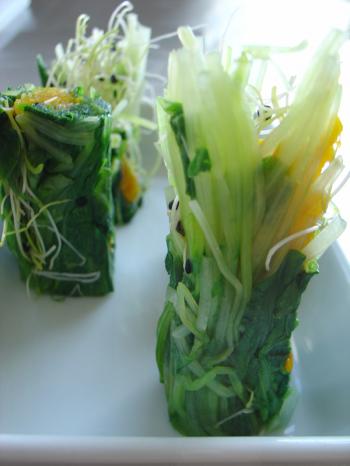
Rescued from the bin: forgotten vegetables transformed into a memorable vegan sushi
40% of all produce is wasted on the route from field to fork. The number is actually more like 60% and it’s easy to understand how the waste becomes heavier if we buy industrially produced food from far away places, highly packaged and marketed. Which is why I don’t do that. My approach to mitigating food waste is by buying less, (as if I ever had to bike to the store mid-week for some greens) and to prepare the leafy greens I get at the farmer’s market into something ’salad ready’ immediately.
For the moments when I still space out and don’t eat everything I buy, beware my Happy Hour! I’ve been developing recipes for forgotten vegetables which will also be used in a soon to open snack restaurant (currently in fetal position) run on the principle of hyper-use. Hyper use of facilities, hyper-use of restaurant expertise and available foodstuffs. The project is called Lucky Mi Fortune Cooking and I’ll be writing about it increasingly in the next few months.
Here is a vegan sushi recipe based upon the Japanese spinach ohitashi salad. It takes just a minute to make and it’s refreshing, beautiful and of course adaptable.
Turnip green and pumpkin Ohitashi-style sushi
- 1 bunch of less than perfect turnip greens (forgotten vegetable syndrome)
- 1 hand full of various sprouted seeds, leek works really well
- 1 spring onion
- 3 tbs. steamed pumpkin, cooled
- fleur de sel or seal salt, ground to a powder
- wasabi paste
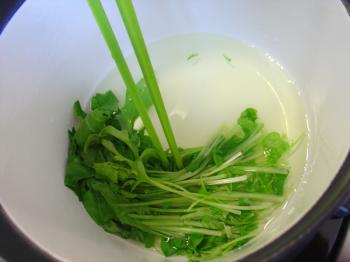
Blanch the greens for but a few seconds, plunge with cold water. Try to keep the leaves going in the same direction, as anal as that may sound, it’s actually easier.
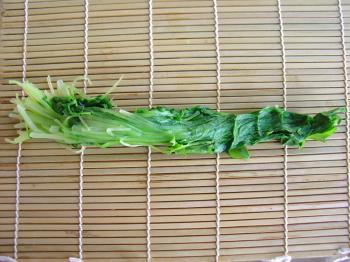
Wring out the greens enthusiastically.
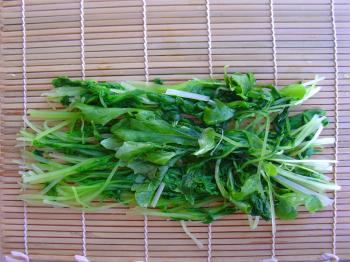
Spread out the greens on your sushi mat and sprinkle with salt.
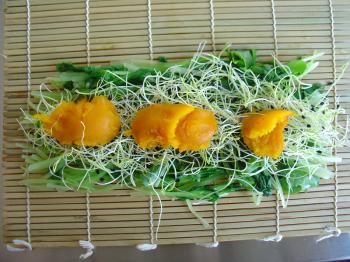
Place sprouts, wasabi paste and pumpkin on the matted green.
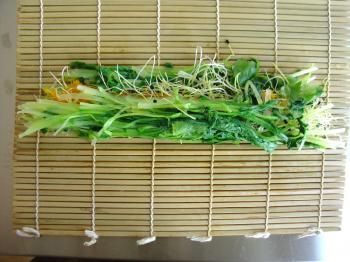
Delicately fold the matted greens over, to start the sushi roll. Use the mat to roll the sushi tightly. Squeeze and squeeze and squeeze… in moderation.
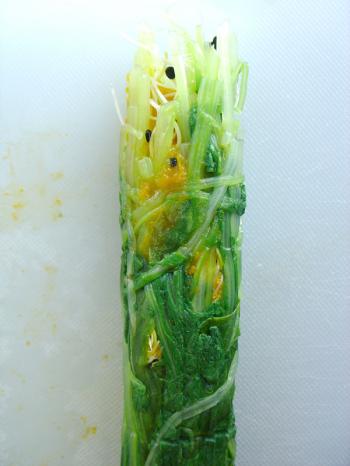
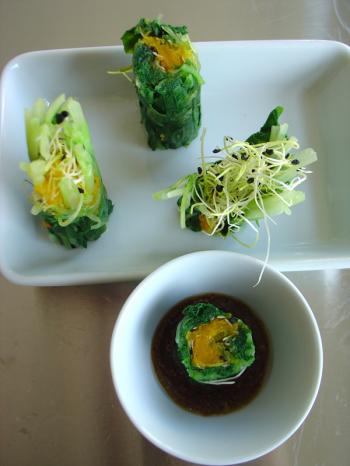 Turn out the sushi onto a cutting board and slice carefully. Serve in or with a puddle of soy sauce, or sesame dressing.
Turn out the sushi onto a cutting board and slice carefully. Serve in or with a puddle of soy sauce, or sesame dressing.
debra at 11:35 | Comments (8) | post to del.icio.us

